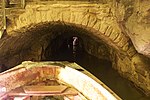Treak Cliff Cavern

Treak Cliff Cavern is a show cave near Castleton in Derbyshire, England. It is part of the Castleton Site of Special Scientific Interest and one of only two sites where the ornamental mineral Blue John is still excavated (the other is the nearby Blue John Cavern). As part of an agreement with English Nature, the Blue John that can be seen in the show cave is not mined but it is extracted in small quantities from other areas of the cave and made into saleable items like bowls, jewellery, and ornaments.The cave comprises two sections, the Old Series, discovered by lead miners in the 18th century, and the New Series, discovered during blasting in the 1920s. Only the Old Series contains Blue John, but the New Series is well decorated with flowstone, stalagmites, and stalactites. Three human skeletons and flint implements from the Neolithic era were found in a small cave nearby in 1921.
Excerpt from the Wikipedia article Treak Cliff Cavern (License: CC BY-SA 3.0, Authors, Images).Treak Cliff Cavern
Buxton Road, High Peak Castleton
Geographical coordinates (GPS) Address External links Nearby Places Show on map
Geographical coordinates (GPS)
| Latitude | Longitude |
|---|---|
| N 53.3451 ° | E -1.7972 ° |
Address
Treak Cliff Cavern
Buxton Road
S33 8WD High Peak, Castleton
England, United Kingdom
Open on Google Maps










